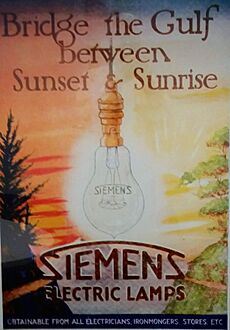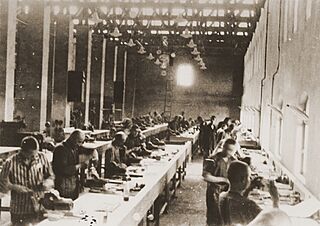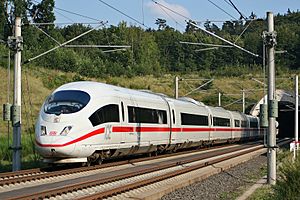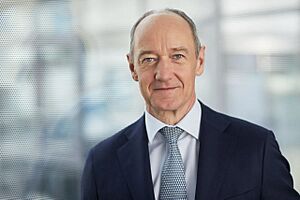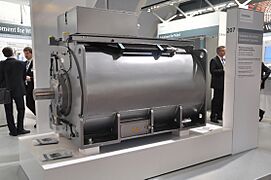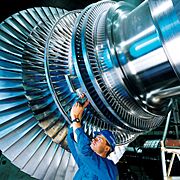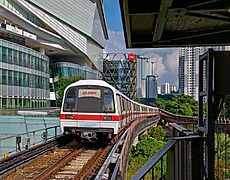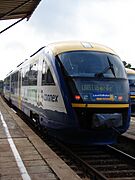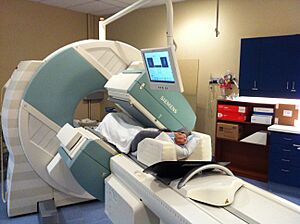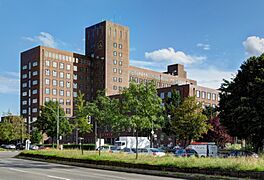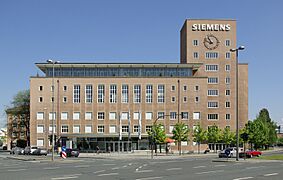Siemens facts for kids
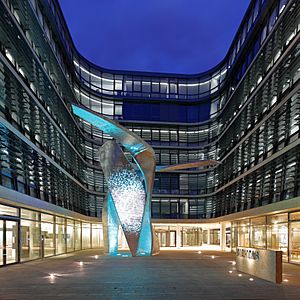
Headquarters in Munich
|
|
| Public | |
| Traded as | |
| ISIN | ISIN: [https://isin.toolforge.org/?language=en&isin=DE0007236101 DE0007236101] |
| Industry | Conglomerate |
| Predecessors |
|
| Founded | 1 October 1847 Berlin, Kingdom of Prussia |
| Founder | Werner von Siemens |
| Headquarters | Munich, Germany |
|
Area served
|
Worldwide |
|
Key people
|
|
| Products | industrial automation, drive technology, building technology, energy technology, financial services, medical technology, mobility services, software |
| Revenue | |
|
Operating income
|
|
| Total assets | |
| Total equity | |
| Owner | Siemens family (6.9%) |
|
Number of employees
|
327,000 (2024) |
| Divisions |
|
Siemens AG is a big German company that works all over the world. It focuses on technology for factories, smart buildings, trains, and healthcare. Siemens is the largest engineering company in Europe. It's also a world leader in factory automation and industrial software.
The company started way back in 1847 in Berlin. It was founded by Werner von Siemens and Johann Georg Halske. The company we know today was formed in 1966. This happened when three older Siemens companies joined together. Today, Siemens has its main offices in Munich and Berlin. It employs about 320,000 people globally. In 2023, the company made about €78 billion in sales. Siemens is one of the biggest companies in Germany.
Siemens has several main parts. These include Digital Industries, Smart Infrastructure, Mobility, and Financial Services. Some parts of Siemens have also become separate companies over time. Examples include Infineon Technologies (semiconductors) and Siemens Energy (energy technology).
Contents
Siemens: A History of Innovation
Early Days: 1847 to 1901
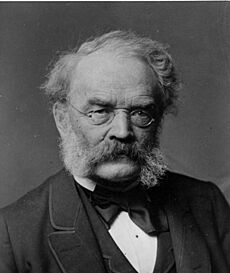
Siemens & Halske was started by Werner von Siemens and Johann Georg Halske on October 1, 1847. They invented a new type of telegraph that used a needle to show letters. This was different from using Morse code. Their first workshop opened on October 12.
In 1848, Siemens built Europe's first long-distance telegraph line. It stretched 500 km from Berlin to Frankfurt am Main. In the 1850s, the company helped build telegraph networks in Russia. By 1867, Siemens finished the huge Indo-European telegraph line. This line was over 11,000 km long, connecting London to Calcutta.
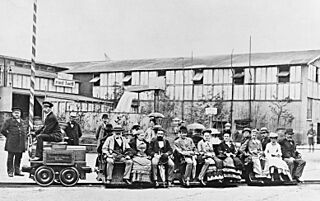
In 1867, Werner von Siemens also described a new kind of dynamo. This machine could create electricity without permanent magnets. In 1881, a Siemens machine powered the world's first electric streetlights. This happened in the town of Godalming, United Kingdom. The company grew and started making electric trains and light bulbs.
By 1887, Siemens opened its first office in Japan. In 1890, Werner von Siemens retired. He left the company to his brother Carl and his sons. In 1892, Siemens built the first full electric tram system in the Southern Hemisphere. This was in Hobart, Australia.
Growing Bigger: 1901 to 1933
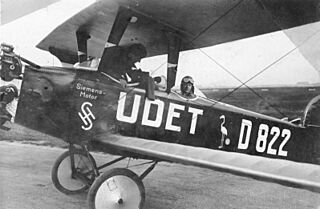
In 1903, Siemens & Halske joined with another company, Schuckert & Co. They formed Siemens-Schuckert. By 1907, Siemens had over 34,000 employees. This made it one of the largest companies in Germany.
In 1919, Siemens helped create the Osram lightbulb company. During the 1920s and 1930s, Siemens started making radios, television sets, and electron microscopes.
In 1932, another important Siemens company was formed. It was called Siemens-Reiniger-Werke AG. This company focused on medical technology. These three main Siemens companies later merged in 1966.
In the 1920s, Siemens also built a large hydroelectric power station. This was the Ardnacrusha station in Ireland. It was a very advanced design for its time.
World War II and After: 1933 to 2001
During World War II, Siemens used forced labor from people in camps. A Siemens factory was located near the Ravensbrück concentration camp. Many Siemens factories were damaged by air raids during the war. So, production was moved to other areas.
After the war, in the 1950s, Siemens started making new products. These included computers, semiconductor devices, washing machines, and pacemakers. In 1966, the three main Siemens companies officially merged. This created the Siemens AG we know today.
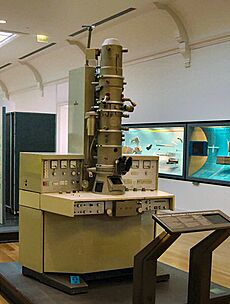
In 1980, Siemens made its first digital telephone exchange. In 1988, Siemens and GEC bought a UK technology company called Plessey. Siemens took over parts of its business, like radar and traffic control.
In 1991, Siemens bought Nixdorf Computer. They renamed it Siemens Nixdorf Informationssysteme. This allowed Siemens to make personal computers. In 1997, Siemens Financial Services (SFS) was created. This part of the company helps with money matters and managing financial risks.
In 1999, Siemens's semiconductor business became a new company. It was called Infineon Technologies. Also, Siemens Nixdorf Informationssysteme became part of Fujitsu Siemens Computers.
Recent Years: 2001 to Present
In 2001, Siemens joined with Areva SA of France. They combined their nuclear power businesses to form Framatome. In 2004, Siemens bought a wind energy company called Bonus Energy. This created the Siemens Wind Power division.
In 2005, Siemens sold its mobile phone manufacturing business to BenQ. This created the BenQ-Siemens division.
Siemens faced issues related to how it secured contracts in some parts of the world. Investigations found that Siemens had used methods to gain contracts that were not allowed. The company worked with investigators to resolve these issues. Siemens paid large fines and changed its internal rules. It also created new ways to prevent such problems in the future. This included setting up a fund to support anti-corruption efforts globally.
In 2007, Siemens merged parts of its network divisions with Nokia. This created a new company called Nokia Siemens Networks. In 2008, Siemens formed a joint venture for its Enterprise Communications business. This company was later renamed Unify.
In 2011, Siemens decided to list Osram on the stock market. Osram makes light bulbs. In September 2011, Siemens announced it would leave the nuclear sector. This decision followed the Fukushima disaster and changes in German energy policy. Siemens supported Germany's plan to switch to renewable energy.
In 2013, Nokia bought out Siemens's share of Nokia Siemens Networks. This ended Siemens's role in telecommunications. In 2014, Siemens announced plans to build a large factory in England. This factory would make offshore wind turbines. This helps Britain expand its wind power.
In 2016, Siemens bought Mentor Graphics. This company makes software for designing electronic products. In 2018, Siemens acquired Mendix, a company that helps build software applications quickly.
In 2020, the energy part of Siemens became a separate company. It is now called Siemens Energy AG. In 2021, Roland Busch became the new CEO of Siemens. In May 2022, Siemens decided to stop its operations in Russia. This was due to the ongoing conflict in Ukraine.
In June 2023, Siemens announced a big investment plan. They planned to spend €2 billion to expand their factories worldwide. This included new plants in Singapore and Chengdu, China. They also planned to invest €1 billion in Germany. This includes expanding a factory in Erlangen and building a new semiconductor factory. In March 2024, Siemens announced a new £100 million digital engineering facility in the UK. This facility will focus on rail infrastructure. In July 2025, Siemens bought Dotmatics, a company that makes software for life sciences research.
What Siemens Does Today
| Business | share |
|---|---|
| Siemens Healthineers | 27.7% |
| Digital Industries | 27.6% |
| Smart Infrastructure | 25.2% |
| Mobility | 13.5% |
| Portfolio Companies | 4.0% |
| Reconciliation | 1.4% |
| Siemens Financial Services | 0.6% |
As of 2023, Siemens has several main divisions. These are Digital Industries, Smart Infrastructure, Siemens Mobility, Siemens Healthineers, and Siemens Financial Services. Siemens Healthineers and Siemens Mobility operate as independent companies. Siemens also has other smaller companies. These are called "Portfolio Companies."
Siemens also has a research and development team called Siemens Technology. Siemens Real Estate manages the company's buildings. Siemens Advanta offers consulting services. next47 is a fund that invests in new companies. Siemens Global Business Services provides shared services for the company.
Digital Industries: Making Factories Smart
The Digital Industries part of Siemens helps factories become more automated. This includes systems for controlling machines and production lines. They also make engines, drives, and sensors. Siemens is a world leader in industrial automation and software.
This division also creates software for designing products. They have a cloud-based system called MindSphere. It connects physical machines to the digital world. This helps factories work smarter. Their software also includes the Mendix platform. It helps people create apps quickly. Key customers are in the car, machine building, and electronics industries.
In 2023, Siemens's CEO, Roland Busch, said the company wants to sell more software. In June 2023, Siemens launched "Siemens Xcelerator." This is a digital platform with hardware, software, and services. Siemens also partnered with Nvidia. They want to use Nvidia's 3D design tools. Xcelerator helps businesses of all sizes use digital tools.
Smart Infrastructure: Building Smarter Cities
Siemens Smart Infrastructure focuses on buildings, electricity, and electrical products. For buildings, they offer systems for automation. This includes controls for heating and air conditioning. They also provide fire safety and security systems.
For electricity, they work on making power grids strong and efficient. This includes software for controlling power systems. They also make equipment for distributing electricity. This division also provides charging stations for electric vehicles.
In renewable energy, Siemens helps build and run microgrids. These are small power grids that often use renewable energy. Microgrids help reduce carbon pollution.
Siemens Mobility: Moving People and Goods
Siemens Mobility is the part of Siemens that deals with transport. This includes making rolling stock like trains for cities, regions, and long distances. They also provide products and services for rail infrastructure. This includes systems for rail automation and railway communication.
In 2019, a planned merger between Siemens Mobility and another company was stopped. This was due to rules about fair competition.
-
Siemens C651 trains used in Singapore
-
Amtrak Siemens SC-44 Charger diesel-electric passenger locomotive
Siemens Healthineers: Advancing Healthcare
Siemens Healthineers AG is a separate company that was created from Siemens in 2017. Siemens still owns most of Siemens Healthineers.
This company provides many healthcare services. They make and sell products for diagnosis and treatment. They also offer consulting and training. Their work is divided into four main areas: imaging, diagnostics, Varian Medical Systems, and advanced therapies. Imaging includes machines like MRI, CT scans, and X-ray machines. The diagnostics part offers products for lab tests. Varian, a company Siemens Healthineers bought, focuses on cancer care. Advanced therapies use images to guide minimally invasive procedures.
Siemens Financial Services: Helping with Money
Siemens Financial Services (SFS) offers many ways to help with money. They provide services for Siemens's customers and other companies. This includes leasing, lending, and financing for projects. SFS also advises Siemens's other businesses on financial risks.
Past Siemens Businesses
Siemens often changes what it focuses on. It sells parts of its business that are no longer central to its main goals. Some major businesses that were once part of Siemens include:
- Deutsche Grammophon/Polydor Records (music companies, sold in 1987)
- Infineon Technologies (semiconductors, spun off in 1999)
- Siemens Mobile (mobile phones, sold in 2005)
- Gigaset Communications (communication devices, spun off in 2008)
- Osram (lighting, spun off in 2013)
- Siemens Energy (energy technology, spun off in 2020)
How Siemens Works
Siemens is based in Germany. Its main headquarters are in Munich.
Business Trends
| Region | share |
|---|---|
| Europe, CIS, Africa, Middle East (without Germany) | 29.7% |
| United States | 24.5% |
| Asia, Australia | 22.1% |
| Germany | 19.0% |
| Americas (without U.S.) | 4.6% |
In 2023, Siemens made €77.7 billion in sales. This was an 8% increase from the year before. As of December 2023, Siemens was worth about US$147 billion. It was one of the two most valuable German companies globally.
The table below shows Siemens's financial trends over the years. Note that in 2020, Siemens Energy became a separate company. This changed Siemens's overall numbers.
| Year | Revenue in €billion |
Net income in €billion |
Total assets in €billion |
Employees |
|---|---|---|---|---|
| 2013 | 75.8 | 4.2 | 101 | 362,000 |
| 2014 | 71.9 | 5.3 | 104 | 357,000 |
| 2015 | 75.6 | 7.2 | 120 | 348,000 |
| 2016 | 79.6 | 5.4 | 125 | 351,000 |
| 2017 | 83.0 | 6.0 | 133 | 372,000 |
| 2018 | 83.0 | 5.8 | 138 | 379,000 |
| 2019 | 86.8 | 5.1 | 150 | 385,000 |
| 2020 | 57.1 | 4.0 | 123 | 293,000 |
| 2021 | 62.2 | 6.1 | 139 | 295,000 |
| 2022 | 71.9 | 3.7 | 151 | 311,000 |
| 2023 | 77.7 | 7.9 | 145 | 320,000 |
| 2024 | 75.9 | 9.0 | 147.8 | 327,000 |
Siemens Locations Around the World
As of 2011, Siemens operates in about 190 countries. It has around 285 factories and production sites.
-
Siemens office building in Erlangen
Research and Development
In 2023, Siemens spent €6.1 billion on research and development. As of September 30, 2022, Siemens had about 46,900 employees working on R&D. The company held around 43,600 patents worldwide.
Siemens Leadership
Siemens has had many leaders throughout its history. Here are some of the people who have led the company:
Chairmen of Siemens AG's Managing Board (1966 to present)
- Gerd Tacke (1968 to 1971)
- Bernhard Plettner (1971 to 1981)
- Karlheinz Kaske (1981 to 1992)
- Heinrich von Pierer (1992 to 2005)
- Klaus Kleinfeld (2005 to 2007)
- Peter Löscher (2007 to 2013)
- Joe Kaeser (2013 to 2021)
- Roland Busch (2021 to present)
Chairmen of the Siemens AG Supervisory Board (1966 to present)
- Ernst von Siemens (1966 to 1971)
- Peter von Siemens (1971 to 1981)
- Bernhard Plettner (1981 to 1988)
- Heribald Närger (1988 to 1993)
- Hermann Franz (1993 to 1998)
- Karl-Hermann Baumann (1998 to 2005)
- Heinrich von Pierer (2005 to 2007)
- Gerhard Cromme (2007 to 2018)
- Jim Hagemann Snabe (2018 to present)
Current Managing Board
- Roland Busch (CEO Siemens AG)
- Klaus Helmrich
- Cedrik Neike (CEO Digital Industries)
- Matthias Rebellius (CEO Smart Infrastructure)
- Ralf P. Thomas (CFO)
- Judith Wiese
Who Owns Siemens?
Siemens has issued 881 million shares of common stock. The Siemens family, who founded the company, still owns 6.9% of the shares. Most of the shares (62%) are owned by large investment companies. The biggest of these is BlackRock. About 84% of the shares are available for public trading. This includes shares owned by the State of Qatar and the Government Pension Fund of Norway. Private investors own 19% of the shares. In terms of nationality, 26% of owners are German. 21% are from the US, followed by the UK (11%), France (8%), and Switzerland (8%).
See also
 In Spanish: Siemens AG para niños
In Spanish: Siemens AG para niños


